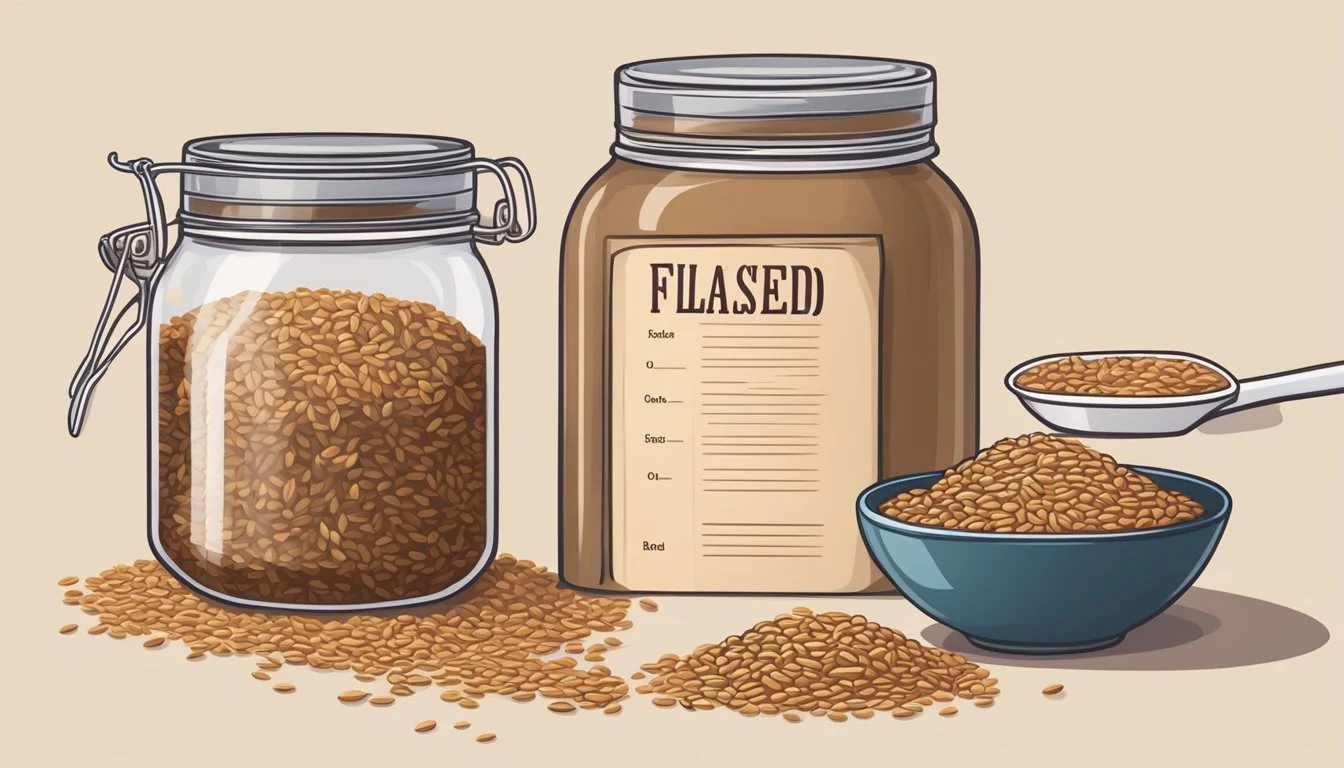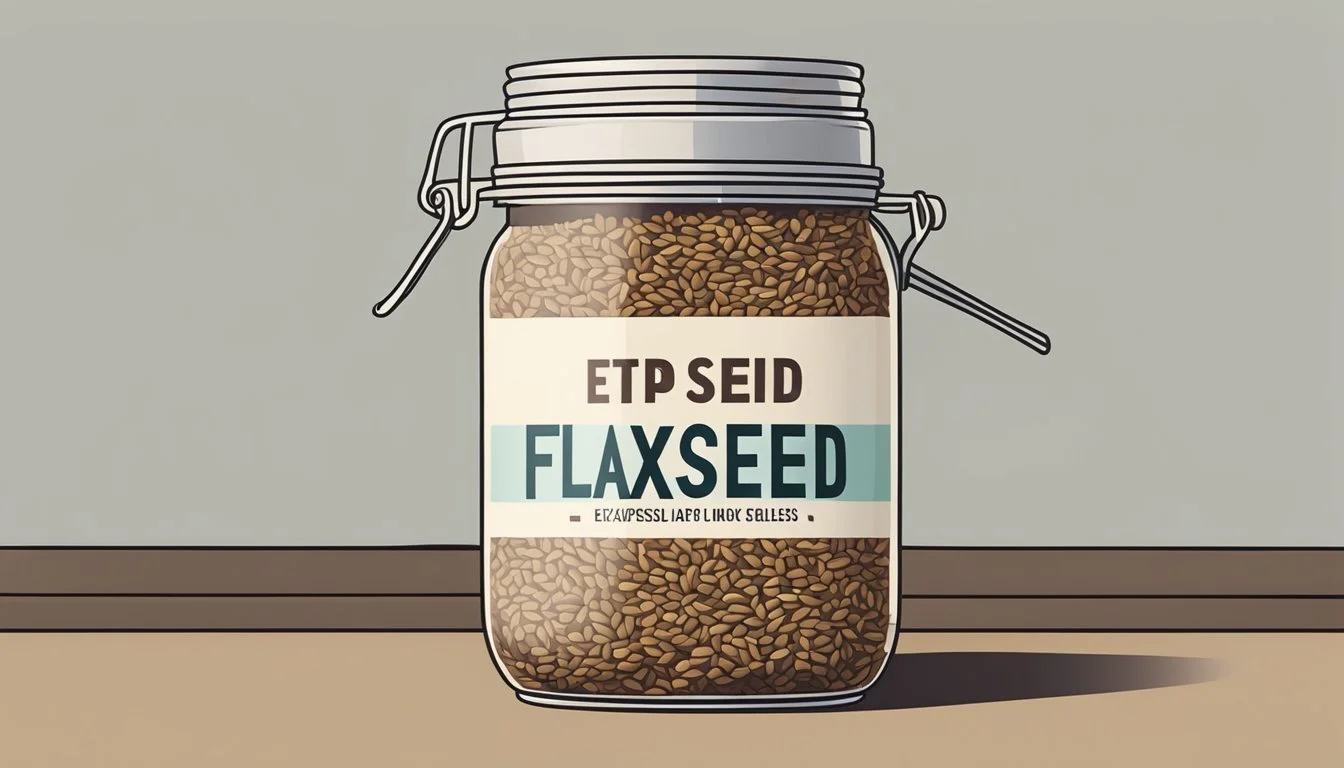Is it Safe to Consume Expired Flaxseed?
Understanding the Risks and Guidelines
When it comes to the consumption of expired flaxseeds, it is necessary to approach the topic with care. Flaxseed is celebrated for its health benefits as a rich source of omega-3 fatty acids, fiber, and protein. As a perishable product with sensitive fats that can easily spoil, flaxseeds have a finite shelf life which raises concerns about safety post-expiration.
The integrity of flaxseeds after the expiration date can be compromised, leading to potential health risks. The natural oils found within flaxseeds are prone to oxidation over time, which can result in rancidity. This is often detectable by an off-putting sour odor or a bitter taste. The presence of these signs usually indicates that the flaxseeds should not be consumed.
Safety is paramount, and while flaxseeds are undeniably nutritious, they are not exempt from spoilage. Consuming rancid flaxseeds can lead to discomfort or possible food poisoning, characterized by symptoms including abdominal pain and fever. As such, it is advised to observe expiration dates closely and perform a smell and taste check before using flaxseeds.
Understanding Flaxseed and Its Health Benefits
Flaxseed, a plant-based food, offers a significant nutrient contribution to a balanced diet, due to its remarkable nutritional profile and associated health advantages.
Nutritional Profile of Flaxseed
Flaxseed provides a robust mix of dietary fiber, proteins, and omega-3 fatty acids. Specifically, ground flaxseed is easier for the body to digest, ensuring maximum nutrient absorption. Here is a quick rundown of the key nutrients found in flaxseed:
Omega-3 fatty acids: Notably alpha-linolenic acid (ALA), critical for heart health
Fiber: Aids in digestion and improves satiety
Protein: Essential for building and repairing tissues
Lignans: Plant compounds with antioxidant properties
Vitamins: Such as Thiamine (Vitamin B1), crucial for energy metabolism
Minerals: Including iron and magnesium
Health Advantages of Consuming Flaxseed
Regular consumption of flaxseed is linked to various health benefits. The fiber content helps maintain digestive health, while the omega-3 fatty acids contribute to reducing inflammation, which can benefit heart health. Flaxseed's lignans have been associated with balancing hormonal levels, potentially reducing the risk of certain cancers. Additionally, its antioxidants may offer protective effects against a range of diseases.
It's important to note that the conversion of ALA in flaxseed to the more active forms of omega-3, EPA and DHA, is limited in humans, yet it still remains a valuable source of this essential fatty acid, especially for those on a plant-based diet.
Shelf Life and Spoilage Indicators
When it comes to flaxseed, shelf life varies depending on whether it's whole or ground. However, despite expiration dates, one can look for specific signs to determine if the flaxseed is safe to consume.
Deciphering Expiration and 'Best By' Dates
Expiration dates on flaxseed packages serve as an estimate for when the product is expected to start losing its peak quality. Whole flaxseeds typically have a shelf life of 1-2 years if stored correctly, while ground flaxseed lasts around a few months. After these periods, one should check for spoilage rather than discarding the flaxseed outright.
Whole Flaxseed: 1-2 years
Ground Flaxseed (Flaxseed Meal): Few months
Physical Signs of Rancidity and Mold
When flaxseeds go bad, they exhibit distinct characteristics that indicate spoilage:
Smell: A rancid or sour odor is a clear sign that flaxseeds are no longer suitable for consumption.
Taste: If flaxseeds have a bitter taste, they may have spoiled.
Appearance: Presence of mold, usually visible as fuzzy spots, makes flaxseeds unsafe to eat.
Consumers should trust their senses to detect spoilage:
Odor: should be absent of rancidity.
Taste: initially nutty, absence of bitterness.
Visual inspection: no signs of mold or discoloration.
Safe Storage Practices
To ensure the safety and nutritional value of flaxseed, proper storage techniques are essential. These practices not only maintain the freshness of flaxseed but also extend its shelf life.
Optimal Storage Conditions
Whole flaxseeds benefit from being stored in a cool, dry, and dark place. An airtight container is optimal to prevent the entry of moisture and other contaminants that can hasten spoilage. The pantry or a cupboard away from heat sources is typically ideal for storage.
For ground flaxseed (flaxseed meal), refrigeration is recommended. The increased surface area from grinding exposes the oils in flaxseed to oxidation, which refrigeration can slow down.
Flaxseed oil should be stored in the fridge in a dark, airtight bottle to maintain its integrity.
The following table summarizes the storage locations for different forms of flaxseed:
Type of Flaxseed Storage Location Whole Flaxseeds Pantry (airtight container) Ground Flaxseed/Meal Refrigerator (airtight container) Flaxseed Oil Refrigerator (dark, airtight bottle)
Extending Flaxseed's Freshness
Freezing flaxseed can further extend its freshness. Both whole and ground flaxseeds can be stored in the freezer in an airtight container, significantly extending their shelf life.
Ground flaxseed, due to its higher propensity to go rancid, should be consumed within a shorter timeframe. For the longest possible freshness, one might opt to grind whole seeds as needed rather than buying pre-ground flaxseed meal.
To determine if flaxseed is still fresh, rely on the smell test. A sour or off odor indicates that the flaxseed has gone bad and should not be consumed.
By adhering to these storage guidelines, one can maintain the freshness and nutritional profile of flaxseed for an extended period.
Impact of Improper Storage
Storing flaxseed incorrectly can lead to increased risks of rancidity and contamination, which may affect both its nutritional value and safety for consumption.
Risks of Oxidation and Spoilage
When flaxseed is exposed to moisture and heat, it can rapidly undergo oxidation. This process not only diminishes the beneficial omega-3 fatty acids but also leads to the seeds spoiling, which can cause digestive discomfort if ingested. Particularly with ground flaxseed, which has a larger surface area exposed to air, the risk of oxidation increases, shortening its shelf life significantly.
Signs of Oxidation:
Off-putting sour odor
Bitter or sharp taste
Taking measures to store flaxseed in a cool, dry place can prevent this type of spoilage and preserve its quality.
Concerns with Pantry Pests and Contaminants
Improper storage can also attract pantry bugs and insects, which can infest the seeds and lead to contamination. Contaminants from these pests pose health risks and can render the flaxseed unsafe to consume.
Preventive Measures:
Airtight containers
Regular inspection of storage areas
Ensuring that flaxseed is kept in sealed containers and away from infestation-prone areas helps maintain its purity and safety for consumption.
Consuming Expired Flaxseed
Flaxseeds have a considerable shelf life, but like all edible products, they can eventually go bad. Here, the focus is on the implications of using expired flaxseeds and their safety for consumption.
Evaluating Safety and Potential Health Risks
Expired flaxseeds can pose health risks due to the potential for spoilage and rancidity. Flaxseeds contain high levels of omega-3 fatty acids, which, when oxidized, produce a sour or fishy smell—a telltale sign of rancidity. Consuming rancid flaxseeds may lead to unpleasant sensory experiences and could cause digestive discomfort or, more seriously, food poisoning.
Indicators of Spoilage:
Smell: Rancid, sour odor
Taste: Bitter or off flavor
Appearance: Noticeable change in color
Consumers should prevent potential health issues by performing a sensory evaluation of the flaxseeds before use. If any signs of spoilage are detected, it is advisable to dispose of the product.
Usage of Expired Flaxseed in Recipes
If flaxseeds pass the initial sensory test but are past the expiration date, they may still be cautiously used in various recipes. This includes incorporation into baked goods where the high cooking temperature may mitigate some spoilage concerns. However, strict attention should be paid to any spoilage indicators prior to and after incorporation into dishes.
Recommendations for Use:
Assess sensory quality carefully before use.
Favor recipes involving baking or cooking, over raw applications.
It is crucial to approach expired flaxseeds with caution as their compromised quality could negatively impact the overall dish and the consumers' health.
Incorporating Flaxseed in Your Diet
Flaxseed is a versatile ingredient that can be incorporated into various meals and beverages, offering nutritional benefits. Care should be taken to replace expired flaxseed with fresh alternatives to ensure optimal health benefits.
Effective Use in Meals and Beverages
In order to effectively incorporate flaxseed into the diet, ground flaxseed, also known as flaxseed meal, is commonly used. The body can more easily digest ground seeds, thereby allowing for better absorption of the nutrients flaxseeds offers. Individuals may add 1 to 4 tablespoons of ground flaxseed to their meals throughout the day. Here are some specific ways to include flaxseed in one's diet:
Breakfast: Mix into oatmeal or cold cereals for a nutty flavor and a boost in fiber.
Smoothies: Blend into smoothies for an added source of omega-3 fatty acids, which can aid in reducing inflammation.
Baking: Use flaxseed meal as an ingredient in baked goods like bread, muffins, and cookies.
Vegan Egg Substitute: Combine ground flaxseed with water to create a vegan egg substitute in recipes.
Storing ground flaxseed properly is crucial for maintaining its nutritional integrity. It should be kept in a cool, dry place, and if possible, in an airtight container in the refrigerator to prolong its shelf-life.
Alternatives to Expired Flaxseed
When flaxseed passes its expiration date, its natural oils may begin to turn rancid, potentially introducing an off flavor, as well as reducing its potential health benefits.
Fresh Ground Flaxseed: Freshly grinding whole flaxseeds before use ensures the oils have not oxidized.
Refrigerated Flaxseed Meal: Purchasing flaxseed meal stored in the refrigeration section can indicate a fresher product.
Sealed Packaging: Look for vacuum-sealed packages of flaxseed meal that can protect against oxidation.
It's important for consumers to be mindful of the flaxseed's shelf life and discard any that has an unpleasant smell or taste, as this may be an indicator of spoilage. Regularly consuming flaxseed within its freshness window can contribute to better digestive health, making it a beneficial addition to a balanced diet.
Frequently Asked Questions (FAQ)
Can one consume flaxseed after the expiry date?
As a general guideline, one should aim to consume flaxseed before the expiry date. The expiry date serves as a good indication of when the flaxseed may start to deteriorate in quality. However, if flaxseeds are stored properly, they may still be safe to consume for a short time after this date.
What happens when flaxseeds go bad?
Flaxseeds contain omega-3 fatty acids, which can oxidize over time. Once spoiled, they may develop a rancid, sour odor. It is suggested to perform a smell test; if the seeds emit an off-putting aroma, they should not be used.
Does it make a difference if the package has been opened?
Yes, an opened package of flaxseed is exposed to air which may accelerate the oxidation process. Hence, opened packages have a shorter shelf life compared to unopened ones.
Storage State Shelf Life Unopened Package Up to 6-12 months Opened Package Varies; use smell test
How can one extend the shelf life of flaxseed?
A nutritionist might suggest keeping flaxseed in a cool, dry place, away from direct sunlight. For longer storage, one can freeze flaxseed to preserve its freshness and slow down the oxidation of omega-3s.
Is there a difference between golden flaxseed and regular flaxseed in terms of expiration?
There is no significant difference between golden and regular flaxseed regarding the expiry date; both types should be stored and handled similarly.
What is the best way to grind flaxseed?
For optimal freshness and nutrient preservation, it's recommended to use a coffee grinder to grind flaxseed in small amounts. Grinding flaxseed in bulk may lead to a quicker spoilage due to increased surface area exposed to air.
Final Thoughts
When assessing the safety of consuming expired flaxseed, one must consider the preservation of fatty acids and prevention of spoilage. Flaxseed contains Omega-3 fatty acids, which are prone to oxidation over time. The shelf life of flaxseed typically ranges from 6 to 12 months, and proper storage is essential to extending this timeline.
Storage Guidelines:
Keep flaxseed in a cool, dry place.
Avoid exposure to direct sunlight.
Use an airtight container to minimize oxidation.
Spoilage Indicators:
A rancid or sour smell suggests spoilage.
An off or bitter taste indicates it's past its prime.
Any unusual color changes are a sign of degradation.
It's recommended to avoid consuming flaxseed that exhibits any of these signs, as it may lead to digestive discomfort and diminished nutritive value. The priority should always be on food safety and ensuring that the nutritional integrity of the seeds is maintained. Hence, consumers should be attentive to the storage conditions and shelf life to determine the optimal usability of flaxseed.









